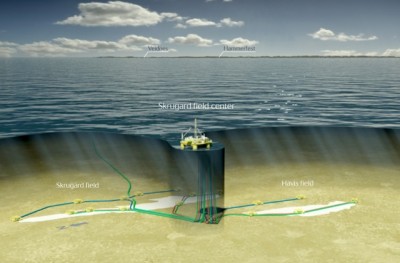The mayor of the area around Norway’s famed North Cape was jubilant this week, after Statoil announced that it intends to bring oil from its huge Skrugard and Havis fields in the Barents Sea to an onshore terminal near Honningsvåg. Statoil and local officials alike hope the new terminal will fuel further exploration and development in the area.

“This is part of the ambition of making Northern Norway the country’s next big petroleum region,” said Øystein Michelsen, Statoil’s executive vice president for Development and Production Norway. “The decision to bring Skrugard oil ashore at Veidnes (outside of Honningsvåg in Finnmark County) is a key element in the further development of the Norwegian oil and gas industry.”
Mayor Kristina Hansen called the plans “mega good news” for the North Cape area and for Finnmark. “This is a milestone for all of us,” Hansen told news bureau NTB. Finnmark officials were disappointed when Italian oil company Eni opted to load oil onto ships at the Goliat field. Hansen thinks bringing the oil from Skrugard and Havis to land (estimated to be twice the amount coming from Goliat) will help develop the community.
‘A new industrial era’
Statoil, which reported record annual profits last week, said its concept will include a floating production unit at the field (scheduled to come on stream in 2018) with a pipeline to shore and a terminal for oil from the Skrugard field. “This may spark off a new industrial era,” Michelsen said. “This concept choice will facilitate further exploration and help make any future discoveries profitable.”

Honningsvåg, also known as a cruise port where thousands of tourists land to visit Nordkapp (the North Cape), has less than 2,500 inhabitants. Statoil’s development plans are warmly welcomed by local politicians and inhabitants eyeing positive ripple effects such as jobs, investment and a general revitalization of the area.
“Nordkapp (the municipality) has suffered from depopulation for about 40 years,” Hansen told newspaper Dagens Næringsliv (DN). “40 percent of the population has disappeared.” She called the prospect of oil-related development “fantastic.”
A modest number of new jobs will be created at the terminal, with figures from 30 to 50 jobs when it’s running at full speed mentioned in various newspapers. According to Aftenposten, around 500-600 people will be needed to help build the plant.
Production from Skrugard and Havis, estimated at almost 200,000 barrels of oil equivalents per day, will be tied to a semi-submersible floating installation through a subsea production system. The oil will be transported through a 280-kilometre pipeline from Skrugard to Veidnes and then directly to an oil storage facility and stored in two mountain caverns, Statoil said.
The plans for the pipeline and terminal are estimated to cost around NOK 10 billion (USD 1.8bn), while the total bill, including the development of Skrugard, will end up at around NOK 80 billion, according to DN. Statoil is the operator of the Skrugard/Havis license with a 50 percent stake. Italy’s Eni has 30 percent and state holding firm Petoro has 20 percent. Skrugard was discovered in April 2011, Havis in January 2012.
Prospects for Skrugard and Havis, along with those for more promising exploration in the area, offered a bright spot for Statoil after weeks of shock and sorrow following terrorist attacks that killed five Statoil employees at a gas plant in Algeria that Statoil operated with BP and Sonatrach. Even though Statoil reported more strong profits last week, the losses in Algeria have taken a toll on the company and Statoil also warned that its future operations at the In Amenas plant were now uncertain. The company appears more bullish than ever on the Norwegian continental shelf.
May generate Lofoten support
Statoil is also hoping that positive effects for the region will help push through a decision to open up areas off Lofoten and Vesterålen to oil exploration, DN reported. Oil exploration in Norway’s vulnerable northern areas, known for rich fishing grounds and spectacular nature, is very much a heated debate.
Only a few weeks ago, the ruling Labour Party (Arbeiderpartiet, AP) made a long-expected but hotly contested decision to pursue the prospect of drilling for oil off Lofoten and Vesterålen, unleashing a storm of protests.
The oil ministry is working on impact assessment and geological mapping related to activity in specified areas in the southeastern Barents Sea, Norway’s new territory bordering Russia, as well as for the waters around the island of Jan Mayen.
Views and News from Norway/Aasa Christine Stoltz
Please support our news service. Readers in Norway can use our donor account. Our international readers can click on our “Donate” button:

